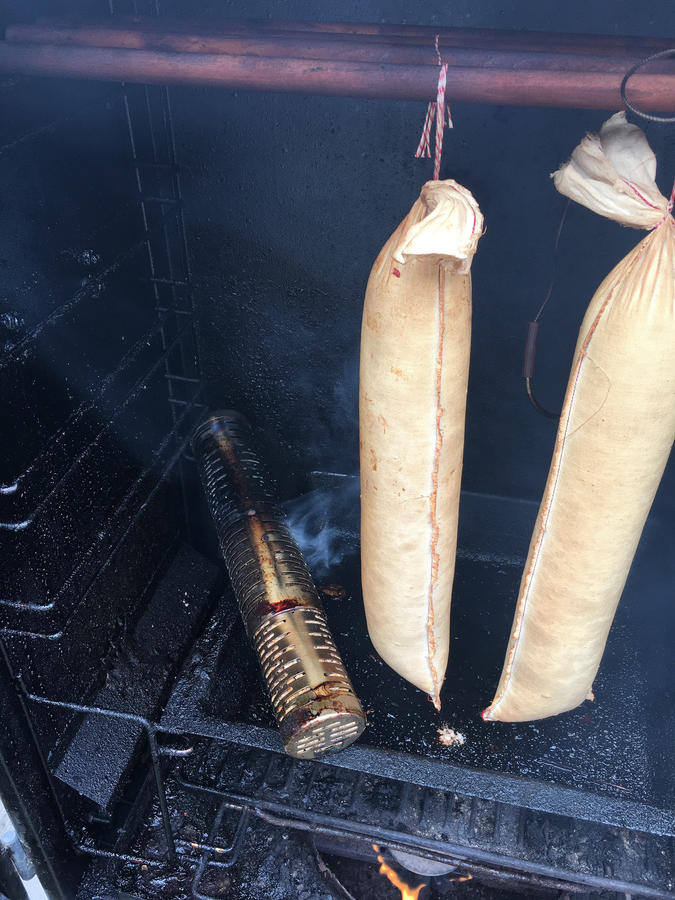So, if I hear you correctly...... After cooking, it is safe to hold food at 65 deg. F for 21.6 hours.... agreed it's only in the dangerous zone and not the most dangerous zone....
So now you are an advocate of NON USDA guidelines.... I wish I knew which set of rules you were going to endorse... this surely gets confusing at times....
We try and promote USDA guidelines, like the owner of the forum Jeff endorses, and you find a way to say we are incorrect...
NO
the numbers don't apply to EVERY food item, in EVERY situation and in ALL conditions. For optimal Safety follow USDA Guidlines for food handling per SMF Guidelines.
In the exclusive and limited
CONTEXT of
THIS discussion and this discussion ONLY... Russell's chart makes a valid point. AGAIN and with out extrapolation to other foods or cooking and holding situations ...With Meat that is cooked, and immediately after reaching a Bacteria killing Safe IT... It is SAFER to cold smoke after Smoking than at the start when the meat is Raw!...JJ
Well, as you are the
FOOD SAFETY PROFESSIONAL on the moderator staff, maybe you could point out the UNSAFE FOOD ITEMS and UNSAFE SITUATIONS and UNSAFE CONDITIONS so our members will have a good understanding of the chart...
According to the FSIS-USDA appendix below, the above chart,
that YOU seem to endorse, is so far out of regulation, it's preposterous...
pre·pos·ter·ous
prəˈpäst(ə)rəs/
adjective
adjective:
preposterous
contrary to reason or common sense; utterly absurd or ridiculous.
http://www.fsis.usda.gov/OPPDE/rdad/FRPubs/95-033F/95-033F_Appendix B.htm
Compliance Guidelines for Cooling Heat-Treated Meat and Poultry Products (Stabilization)
[h4]Stabilization Guidelines[/h4]
It is very important that cooling be continuous through the given time/temperature control points. Excessive dwell time in the range of 130° to 80°F is especially hazardous, as this is the range of most rapid growth for the clostridia. Therefore cooling between these temperature control points should be as rapid as possible.
1. During cooling, the product's maximum internal temperature should not remain between 130°F and 80°F for more than 1.5 hours nor between 80°F and 40°F for more than 5 hours. This cooling rate can be applied universally to cooked products (e.g., partially cooked or fully cooked, intact or non-intact, meat or poultry) and is preferable to (2) below.
2. Over the past several years, FSIS has allowed product to be cooled according to the following procedures, which are based upon older, less precise data: chilling should begin within 90 minutes after the cooking cycle is completed. All product should be chilled from 120°F (48°C) to 55°F (12.7°C) in no more than 6 hours. Chilling should then continue until the product reaches 40°F (4.4°C); the product should not be shipped until it reaches 40°F (4.4°C).
This second cooling guideline is taken from the former ("Requirements for the production of cooked beef, roast beef, and cooked corned beef", 9 CFR 318.17(h)(10)). It yields a significantly smaller margin of safety than the first cooling guideline above, especially if the product cooled is non-intact product. If an establishment uses this older cooling guideline, it should ensure that cooling is as rapid as possible, especially between 120 °F and 80°F, and monitor the cooling closely to prevent deviation. If product remains between 120 °F and 80 °F more than one hour, compliance with the performance standard is less certain.
3. The following process may be used for the slow cooling of ready-to-eat meat and poultry cured with nitrite. Products cured with a minimum of 100 ppm ingoing sodium nitrite may be cooled so that the maximum internal temperature is reduced from 130 to 80 °F in 5 hours and from 80 to 45 °F in 10 hours (15 hours total cooling time).
This cooling process provides a narrow margin of safety. If a cooling deviation occurs, an establishment should assume that their process has exceeded the performance standard for controlling the growth of Clostridium perfringens and take corrective action. The presence of the nitrite, however, should ensure compliance with the performance standard for Clostridium botulinum.
Establishments that incorporate a "pasteurization" treatment after lethality and stabilization treatments (e.g., applying heat to the surface of a cooled ready-to-eat product after slicing) and then re-stabilize (cool) the product should assess the cumulative growth of
C. perfringens in their HACCP plans. That is, the entire process should allow no more than 1-log[sub]10 [/sub]total growth of
C. perfringens in the finished product. When employing a post-processing "pasteurization," establishments may want to keep in mind that at temperatures of 130 °F or greater,
C. perfringens will not grow.
Support documentation for this process was filed by the National Food Processors Association on April 14, 1999. It is available for review in the FSIS Docket Room, Room 102, Cotton Annex, 300 12th St., SW, Washington, DC 20250-3700.











